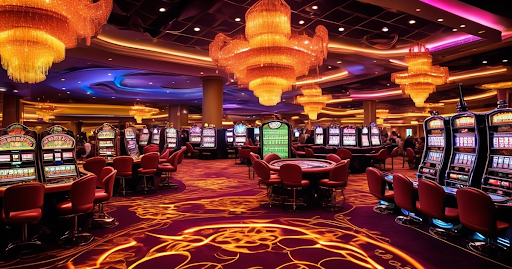Across the globe, the allure of slot machines has enchanted millions, transcending cultural barriers and drawing in a wide array of players. From the bustling casinos of Vegas to the colorful gaming halls of Macau’s gaming centers, these enchanting machines have become emblems of excitement and expectation. The spinning reels and colorful graphics draw players into deeply engaging experiences, creating a distinct blend of chance and entertainment that strikes a chord with people from all walks of life. https://bl555.run/
As these games evolve, their impact extends beyond simple betting; they influence cultural trends, spark art, and reshape social interactions. Whether it’s through cinematic representations of casino life or the rise of internet-based slots that bring the excitement of gambling to the convenience of home, the cultural significance of gambling slots continues to grow. Exploring this phenomenon reveals more than the rules of play, but also the meaningful bonds they foster within communities and their role in the wider tapestry of leisure activities across the world.
Account of Gambling Slots
The roots of gambling slots can be tracked back the final nineteenth century with the invention of the initial mechanical slot machine. In the year 1887, Charles Fey, a mechanic from SF, created the first mechanical slot machine, which had three spinning reels and a simple design with icons such as horseshoe symbols and card symbols. This machine provided players a opportunity to win tokens, laying the foundation for what would become a universal gaming sensation.
As the popularity of casino slots increased, various advancements emerged throughout the early 20th century. By the early 1900s, numerous companies began producing their versions, enhancing the games with additional features and more complex functions. These early devices became a fixture in pubs, saloons, and ultimately started to make their way into gambling halls. By the 1960s, the mechanical slot machine was further improved with the introduction of electronic components, leading to more diverse gameplay and increased player involvement.

The 1980s marked a major turning point when video technology was integrated into slot machines. This innovation allowed for more elaborate graphics, audio, and themes, drawing in a larger audience. The combination of stunning visuals and engaging gameplay changed gambling machines into a major highlight in casinos around the globe. As a consequence, slots evolved from basic machines into elaborate entertainment units, reflecting changing cultural tastes and technological advancements.
Cultural Diversity within Slot Gaming
Gambling slot games have evolved in order to represent various cultures along with customs from different regions where they are played. As an example, in Japan, for example, pachinko devices merge elements of pinball alongside conventional slot games, resulting in a one-of-a-kind gaming experience which is thoroughly rooted inside Japanese entertainment culture. Such devices typically incorporate well-known anime figures along with themes, showcasing the connection between gaming in pop culture in Japanese culture.
On the other hand, within the US, gambling machines tend to be themed around popular cinematic works, famous people, and recognizable icons of U.S. society. This practice demonstrates a tendency to exalt and commercialize pop culture, allowing the gambling experience accessible to gamers. The vibrant visuals and effects aim in order to create enthusiasm as well as entice players into the gambling experience, showcasing American innovation for the entertainment industry and technology.
Across Europe regions also maintain distinct specific approaches toward slot games. As an example, in the United Kingdom, such as, classic fruit machines found within pubs as well as arcades reflect regional likes for classic game designs. Such machines often focus on basic layouts while also clear-cut gameplay, that speak well among gamers that cherish a fond gaming experience. This kind of geographical difference emphasizes how societal influences mold the evolution as well as success of casino slot games across different areas in the world.
The Evolution of Casino Slot Machines
As technology continues to evolve, the prospects of casino slots appears promising and exciting. Innovations in gaming technology, such as VR and AR, are likely to redefine how players interact with slots. Imagine stepping into a virtual casino where players can interact with their surroundings more immersively, making the act of spinning the reels more thrilling and engaging than before. This shift could also draw in a new audience, ushering in a new era of casino gaming.
Moreover, the integration of artificial intelligence and large-scale data analytics will enhance customization in casino slots. Players can expect games tailored to their individual tastes, as AI assesses their patterns and actions. This customization not only makes the gaming experience more enjoyable but also encourages player retention, as casinos strive to meet individual player needs. Future slot games will likely feature more immersive narratives and vivid content, expanding the boundaries of traditional gameplay.
Finally, the rise of mobile gaming will continue to transform the future of casino slots around the world. As more players turn to smartphones and tablets for entertainment, casino operators will concentrate efforts on optimizing their games for mobile platforms. This convenience allows for more accessible play, with players able to play their favorite slots anytime and anywhere. As the global gaming market grows, the evolution of casino slots will play a crucial role in attracting new players and maintaining the thrill of existing fans.
